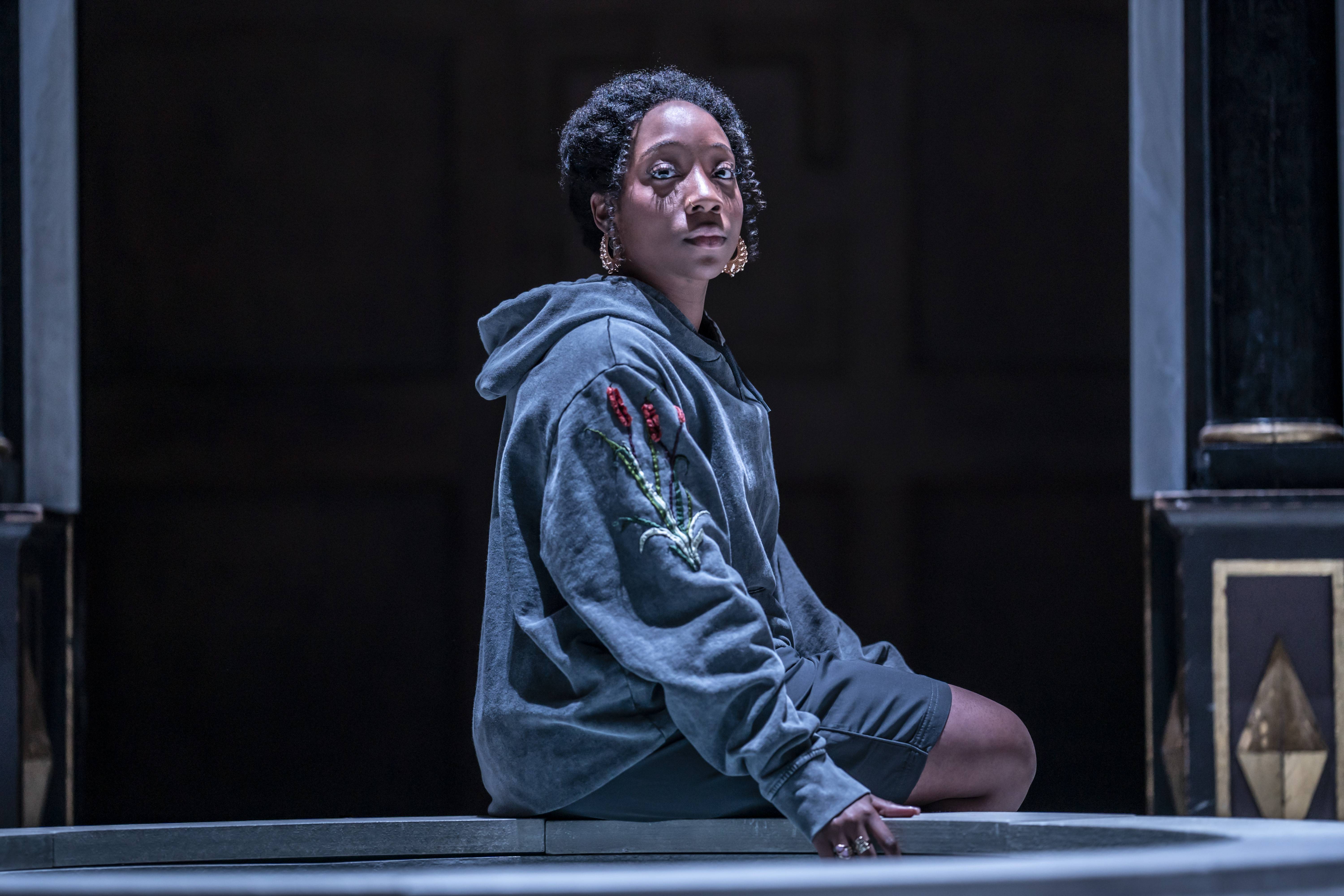This Globe Theatre production, staged in the Sam Wanamaker Playhouse, completes an informal season of Hamlets that began with Ian McKellen’s age-blind Dane at the Theatre Royal Windsor, followed by Cush Jumbo’s gender-blind Dane at the Young Vic. Sean Holmes’s production, with George Fouracres as the Prince, seeks to subvert the standard tropes, and our expectations, of Shakespeare’s most famous play further. Sporting a baggy paisley shirt, an earring, Fouracres’s natural Black Country accent and a seeming-devotion to The Smiths – including regular breaks to sing snatches of I Know It’s Over and Big Mouth Strikes Again – this Hamlet is sardonic from the outset but full of tenderness too.
Holmes makes the most of the Sam Wanamaker’s beautiful candlelit space; throwing the playhouse into pitch darkness on the first arrival of King Hamlet’s Ghost (Ciaran O’Brien) we are left scanning the darkness for the sign of voices. On the Ghost’s second visit the cast pursue the Ghost with single candles, throwing shadows and shapes across the playhouse as they move around the space behind the stage seeking the Ghost. Accompanied by Ed Gaughan’s eerie guitar-work it is truly chilling.
 |
| George Fouracres as Hamlet. Photo: Johan Persson |
There are anachronisms and subversions abound; ‘fuck you Fortinbras’ shouts Claudius (Irfan Shamji) on learning that Fortinbras’s plan of invasion has failed, while Hamlet issues an under-breath ‘dickhead’ during his fencing match with Laertes (Nadi Kemp-Sayf). Such touches are relatively minor, you might think. In which case, you may not be ready for the ten-minute stand-up routine by Gaughan (nominally ‘the Gravedigger’ here) featuring references to ITV’s The Chase and lockdown parties, followed by a sing-along to Kenny Rodger’s The Gambler. It’s entertaining but does it work here? At 3+ hours there may be many wondering if the comic-music interlude was needed.
Holmes subverts in other ways too. Gone is the usual mix-up between Rosencrantz (Francesca Henry) and Guildenstern’s (Ciaran O’Brien again) identities; the Hecuba speech is replaced by a scene from Romeo and Juliet; while Ophelia (Rachel Hannah Clarke) is thrust into performing Hamlet’s ‘12 or 16 lines’ he has inserted into the play the Players perform on the night of their arrival – not to mention that there is more audience participation than your local panto. Some of this works and some of it doesn’t. The enhanced role of the audience seems to create an environment where we are ready for comedy and therefore laugh at certain scenes where laughs were probably not intended. However, the forced inclusion of the clearly unwilling Ophelia in the Players’ play is fascinating in the way in which it demonstrates the demeaning manipulation of Ophelia by Hamlet.
 |
| The cast of Hamlet. Photo: Johan Persson |
The playhouse’s space is again used magnificently to bring the panic following the Players play to life – while Hamlet and Horatio (Peter Bourke) debrief on stage, the cast storm around the corridors that encircle the playhouse behind the audience. There is a feeling of being in the middle of the panic, in the middle of the action, in the middle of a whirlwind that is about to blow out of control.
There are fantastic performances throughout the cast. Fouracres makes his mordant humour Hamlet’s strength, cutting through what Hamlet perceives as nonsense with a cutting remark – ‘oh’ he reacts sarcastically with a bemused shake of his head as he is informed that Fortinbras and his troops have arrived as he himself teeters on the edge of his inescapable death. He laughs at his own over-dramatic assertions and has a genuine tenderness, though his occasional sobs feel inauthentic. Does this Hamlet really care?
 |
| Rachel Hannah Clarke as Ophelia. Photo: Johan Persson |
Meanwhile, John Lightbody’s debonair Polonius is sensational, threatening to steal every scene. He perfectly pitches his Polonius as sober and solemn with an increasing touch of camp as the play progresses. There are rising giggles from the audience as he carefully lifts his reading glasses, from where the rest on their beaded chain around his neck, to his eyes to read Hamlet’s love letters aloud. Ciaran O’Brien bring a uniqueness to each of his roles but is best when inhabiting the fury of King Hamlet’s Ghost. Polly Frame’s progression of Gertrude suggests that she is descending into a madness of her own, while Clarke provides a touching portrayal of Ophelia’s own descent with Grace Smart’s stage design providing a physical monument to Ophelia’s death through the use of a stone pool as both a reflection of the way in which she died and her grave itself.
It is difficult, then, to succinctly sum up Holmes’s production. Much in the way that Polonius recites the Players’ talents for ‘tragedy, comedy, history, pastoral, pastoral-comical, historical-pastoral, tragical-historical, tragical-comical-historical-pastoral’, I too could recite this productions talents for tragedy, comedy, drama, melodrama, tragic-comedy, comedy-melodrama, etc, etc. But it is not quite one of them and not quite all of them – it is a mix of everything, and so too is life. Some might argue that more matter with less art next time might work better, but regardless, there are moments and performances here that make this production worth seeing. George Fouracres’s Hamlet is the best of the season.
Hamlet is at the Sam Wanamaker Playhouse at Shakespeare’s Globe until 9 April















